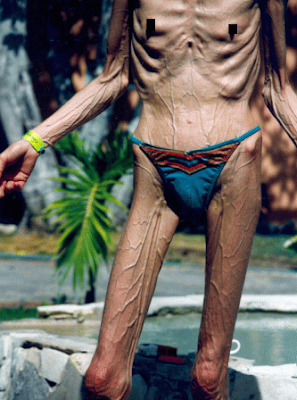
Starvation experiment participant Sam Legg
There are striking parallels between victims of semi-starvation/starvation and those who suffer from bulimia and/or anorexia nervosa.

Physiologist Ancel Keys led the starvation experiment
Probably the most systematic study of the effects of starvation was conducted over 30years ago by Ancel Keys and his colleagues at the University of Minnesota (Keys, Brozek, Henschel, Mickelsen & Taylor, 1950). The experiment, commonly referred to as the Minnesota Starvation Experiment/Study, involved restricting the caloric intake of 36 young, healthy, psychologically normal men who had volunteered for the study as an alternative to military service.
During the first three months of the experiment, the men ate normally, while their behavior, personality, and eating patterns were studied in detail. During the subsequent six months, the men were restricted to approximately half of their former food intake and lost, on average, 25% of their original body weight. This was followed by three months of rehabilitation, during which time the men were gradually re-fed.
Although their individual responses varied considerably, the men experienced dramatic physical, psychological, and social changes as a result of the starvation. In most cases, these changes persisted during the rehabilitation or re-nourishment phase.
An inevitable result of starvation was a dramatic increase in preoccupation with food. The men found concentration on their usual activities increasingly difficult, since they were plagued by persistent thoughts of food and eating. In fact, food became a principal topic of conversation, reading, and daydreams. Many of the men began reading cookbooks and collecting recipes.

Starvation subjects became overwelmingly preocupied with food.
Some collected dozens of cookbooks
Some developed a sudden interest in collecting coffee-pots, hot plates, and other kitchen utensils. This hoarding even extended to non-food-related items:
Some of the men collected old books, unnecessary second-hand clothes, knick knacks, and other "junk." Often after making such purchases, which could be afforded only with sacrifice, the men would be puzzled as to why they had bought such, more or less, useless articles. (Keys et al., 1950, p. 837)
One man even began rummaging through garbage cans with the hope of finding something that he might need. This general tendency to hoard has been observed in starved anorexic patients (Crisp, Hsu, & Harding, 1980) and even in rats deprived of food (Fantino & Cabanac, 1980).
Despite little interest in culinary matters prior to the experiment, almost 40% of the men mentioned cooking as part of their post-experiment plans. For some, the fascination was so great that they actually changed occupations after the experiment: three became chefs, and one went into agriculture.
During starvation, the volunteers' eating habits underwent remarkable changes. The men spent much of the day planning how they would eat their allotment of food. Much of their behavior served the purpose of prolonging the ingestion and hedonic appeal or saliency of food. The men often ate in silence and devoted total attention to consumption.

The Minnesota subjects were often caught between conflicting desires to gulp their food down ravenously and consume it slowly so that the taste and odour of each morsel would be fully appreciated. Toward the end of starvation, some of the men would dawdle for almost two hours over a meal which previously they would have consumed in a matter of minutes. (Keys et al.,1950, p. 833)
The men demanded that their food be served hot, and they made unusual concoctions by mixing foods together. There was a tremendous increase in the use of salt and spices. The consumption of coffee and tea increased so dramatically that the men had to be limited to 9 cups per day; similarly, gum chewing became excessive and had to be limited after it was discovered that one man was chewing as many as 40 packages a day.
During the 12-week rehabilitation phase, most of these attitudes and behaviors persisted. For a small number of men, these became even more marked during the first six weeks of refeeding:
In many cases the men were not content to eat "normal" menus but persevered in their habits of making fantastic concoctions and combinations. The free choice of ingredients, moreover, stimulated "creative" and "experimental" playing with food, licking of plates, and neglect of table manners persisted. (Keys et al., 1950, p. 843)
BulimiaDuring the starvation regimen, all of the volunteers reported increased hunger; some appeared able to tolerate the experience fairly well, but for others it created intense concern, or even became intolerable. Several men failed to adhere to their diets and reported episodes of
bulimia followed by self-reproach. While working in a grocery store, one subject suffered a complete loss of willpower and ate several cookies, a sack of popcorn, and two overripe bananas before he could "regain control" of himself. He immediately suffered a severe emotional upset, with nausea, and upon returning to the laboratory he vomited. He was self-deprecatory, expressing disgust and self-criticism. (Keys et al., 1950,p. 887)
During the eighth week of starvation, another subject
"flagrantly broke the dietary rules, eating several sundaes and malted milks; he even stole some penny candies. He promptly confessed the whole episode, [and] became self-deprecatory" (Keys et al.,1950, p. 884).
When presented with greater amounts of food during rehabilitation, many of the men lost control of their appetites and "ate more or less continuously" (Keys et al., 1950, p. 843). Even after 12 weeks of rehabilitation, the men frequently complained that they experienced an increase in hunger immediately following a large meal:
[One of the volunteers] ate immense meals (a daily estimate of 5,000 to 6,000 calories) and yet started snacking" an hour after he finished a meal. [Another] ate as much as he could hold during the three regular meals and ate snacks in the morning, afternoon and evening. (Keys et al., 1950, p. 846)
This gluttony resulted in a high incidence of headaches, gastrointestinal distress and unusual sleepiness. Several men had spells of nausea and vomiting. One man required aspiration and hospitalization for several days. (Keys et at., 1950, p. 843)

There were weekend "splurges" in which intake commonly ranged between 8,000 and 10,000 calories. The men frequently found it difficult to stop eating:
"Subject No. 20 stuffs himself until he is bursting at the seams, to the point of being nearly sick and still feels hungry; No. 120 reported that he had to discipline himself to keep from eating so much as to become ill; No. 1 ate until he was uncomfortably full; and subject no. 30 had so little control over the mechanics of "piling it in" that he simply had to stay away from food because he could not find a point of satiation even when he was "full to the gills." . . . Subject no. 26 would just as soon have eaten six meals instead of three." (Keys et al., 1950, p. 847)
After about five months of rehabilitation, the majority of the men reported some normalization of their eating patterns; however, for some the extreme overconsumption persisted:
"No. 108 would eat and eat until he could hardly swallow any more, and then he felt like eating half an hour later" (Keys et al., 1950, p. 847).
More than 8 months after renourishment, a few men were still eating abnormal amounts, and one man still reported consuming
"about 25 per cent more than his pre-starvation amount; once he started to reduce but got so hungry he could not stand it" (Keys et al., 1950, p. 847).
Factors that distinguished men who rapidly normalized their eating from those who continued to eat prodigious amounts were not identified. However, the important point here is that there were tremendous differences among volunteers in their responses to the starvation experience, and that a subset of these men developed
bulimia, which persisted many months after they were permitted free access to food.
Emotional ChangesThe strict procedures used to select subjects for the experiment led the experimenters to conclude that the "psychobiological 'stamina' of the subjects was unquestionably superior to that likely to be found in any random or more generally representative sample of the population" (Keys et al., 1950, p. 916). Although the subjects were psychologically healthy prior to the experiment, most experienced significant emotional changes as a result of semi-starvation. Some reported transitory and others protracted periods of depression, with an overall lowering of the threshold for depression. Occasionally elation was observed, but this was inevitably followed by "low periods." Although the men had quite tolerant dispositions prior to starvation, tolerance was replaced by irritability and frequent outbursts of anger. For most subjects, anxiety became more evident.
As the experiment progressed, many of the formerly even-tempered men began biting their nails or smoking because they felt nervous. Apathy became common, and some men who had been quite fastidious neglected various aspects of personal hygiene. Most of the subjects experienced periods during which their emotional distress was quite severe, and all exhibited the symptoms of "semi-starvation neurosis" described above.
Almost 20% of the group experienced extreme emotional deterioration that markedly interfered with their functioning. Standardized personality testing with the
Minnesota Multiphasic Personality Inventory (MMPI) revealed that semi-starvation resulted in significant increases in depression, hysteria, and hypochondriasis for the group. This profile has been referred to as the "neurotic triad" and is observed among different groups of neurotically disturbed individuals (Greene, 1980). These emotional aberrations did not vanish immediately during rehabilitation, but persisted for several weeks, with some men actually becoming more depressed, irritable, argumentative, and negativistic than they had been during semi-starvation.
During semi-starvation two subjects developed disturbances of "psychotic" proportions. One of these was unable to adhere to the diet and developed alarming symptoms:
"[He exhibited] a compulsive attraction to [garbage] and a strong, almost compelling, desire to root in garbage cans [for food to eat]. He repeatedly went through the cycle of eating tremendous quantities of food, becoming sick, and then starting all over again [and) became emotionally disturbed enough to seek admission voluntarily to the psychiatric ward of the University Hospitals." (Keys et al., 1950, p. 890)
After nine weeks of starvation, another subject exhibited signs of disturbance:
"[He went on a] spree of shoplifting, stealing trinkets that had little or no intrinsic value. He developed a violent emotional outburst with flight of ideas, weeping, talk of suicide and threats of violence. Because of the alarming nature of his symptoms, he was released from the experiment and admitted to the psychiatric ward of the University Hospitals." (Keys et al., 1950, p. 885)
Another man chopped off three fingers of one hand in response to stress.For a few volunteers, mood swings were extreme:
"[One subject] experienced a number of periods in which his spirits were definitely high. These elated periods alternated with times in which he suffered "a deep dark depression." [He] felt that he had reached the end of his rope [and] expressed the fear that he was going crazy [and] losing his inhibitions." (Keys et al., 1950, p. 903)
Personality testing (with the MMPI) of a small minority of subjects confirmed the clinical impression of incredible deterioration as a result of semi-starvation.
"...one man's personality profile [was] initially...well within normal limits, but after 10 weeks of semi-starvation and a weight loss of only about 4.5 kg (10 lb, or approximately 7% of his original body weight), gross personality disturbances were evident." On the second testing, all of the MMPI scales were elevated, with severe personality disturbance on the scales for neurosis as well as those for psychosis. Depression and general disorganization were particularly striking consequences of starvation for several of the men who became the most emotionally disturbed.
It may be concluded from clinical observation as well as standardized personality testing that the individual emotional response to semi-starvation conditions varies considerably. Some of the volunteers in Keys et al.'s experiment seemed to cope relatively well, and others displayed extraordinary disturbance following weight loss. The type of disturbance was quite similar to that described in obese individuals exposed to "therapeutic" semi-starvation (Glucksmaii & Hirsch, 1969; Rowland, 1970).
In the Minnesota experiment, pre-starvation personality adjustment did not predict the emotional response to caloric restriction. Some of the men who appeared to be the most stable reacted with severe disturbance. The fact that people respond so differently and unpredictably to weight loss is clearly relevant to an assessment of those who have dieted below their optimal weight.
Since the emotional difficulties in the Minnesota volunteers did not immediately reverse themselves during rehabilitation, it may be assumed that the abnormalities were related more to body weight than to short-term caloric intake. It may be concluded that many of the psychological disturbances found in
anorexia nervosa and
bulimia may be the result of the semistarvation process.
Social and Sexual ChangesThe extraordinary impact of semi-starvation is reflected in the social changes experienced by most of the volunteers. Although originally quite gregarious, the men became progressively more withdrawn and isolated. Humour and the sense of comradeship diminished markedly amidst growing feelings of social inadequacy:
Social initiative especially, and sociability in general, underwent a remarkable change. The men became reluctant to plan activities, to make decisions, and to participate in group activities. They spent more and more time alone. It became "too much trouble" or "too tiring" to have contact with other people. (Keys et al., 1950, pp. 836-837)
The volunteers' social contacts with women also declined sharply during semi-starvation. Those who continued to see women socially found that the relationships became strained. These changes are illustrated in the description from one man's diary:
"I am one of about three or four who still go out with girls. I fell in love with a girl during the control period but I see her only occasionally now. It's almost too much trouble to see her even when she visits me in the lab. It requires effort to hold her hand. Entertainment must be tame. If we see a show, the most interesting part of it is contained in scenes where people are eating." (Keys et al., 1950, p. 853)
Sexual interests were likewise drastically reduced. Masturbation, sexual fantasies, and sexual impulses either ceased or became much less common. One subject graphically stated that he had
"no more sexual feeling than a sick oyster." (Even this peculiar metaphor made reference to food.) The investigators observed that
"many of the men welcomed the freedom from sexual tensions and frustrations normally present in young adult men" (Keys et al., 1950, p. 840).
The fact that starvation perceptibly altered sexual urges and associated conflicts is of particular interest, since it has been hypothesized that this process is the driving force behind the dieting of many
anorexia nervosa patients. According to Crisp (1980),
anorexia nervosa is an adaptive disorder in the sense that it curtails sexual concerns for which the adolescent feels unprepared.
During rehabilitation, sexual interest was slow to return. Even after three months, the men judged themselves to be far from normal in this area. However, after eight months of re-nourishment, virtually all of the men had recovered their interest in sex.
Cognitive ChangesThe volunteers reported impaired concentration, alertness, comprehension, and judgment during semi-starvation; however, formal intellectual testing revealed no signs of diminished intellectual abilities.
Physical ChangesAs the six months of semi-starvation progressed, the volunteers exhibited many physical changes, including the following: gastrointestinal discomfort, decreased need for sleep, dizziness, headaches, hypersensitivity to noise and light, reduced strength, poor motor control, edema (an excess of fluid causing swelling), hair loss, decreased tolerance for cold temperatures (cold hands and feet), visual disturbances (i.e. inability to focus, eye aches, "spots" in the visual fields), auditory disturbances (i.e. ringing noise in the ears), and paresthesia (i.e. abnormal tingling or prickling sensations, especially in the hands or feet).
Various changes reflected an overall slowing of the body's physiological processes. There were decreases in body temperature, heart rate, and respiration, as well as in basal metabolic rate (BMR). BMR is the amount of energy (calories) that the body requires at rest (i.e. no physical activity) in order to carry out normal physiological processes. It accounts for about two-thirds of the body's total energy needs, with the remainder being used during physical activity. At the end of semi-starvation, the men's BMRs had dropped by about 40% from normal. This drop, as well as other physical changes, reflects the body's extraordinary ability to adapt to low caloric intake by reducing its need for energy. One volunteer described that it was as if his
"body flame [were] burning as low as possible to conserve precious fuel and still maintain life process" (Keys et al., 1950, p. 852).
During rehabilitation, metabolism again speeded up, with those consuming the greatest number of calories experiencing the largest rise in BMR. The group of volunteers who received a relatively small increment in calories during rehabilitation (400 calories more than during semi-starvation) had no rise in BMR for the first three weeks. Consuming larger amounts of food caused a sharp increase in the energy burned through metabolic processes.
The changes in body fat and muscle in relation to overall body weight during semi-starvation and rehabilitation are of considerable interest.
While weight declined about 25%, the percentage of body fat fell almost 70%, and muscle decreased about 40%. Upon re-feeding, a greater proportion of the "new weight" was fat; in the eighth month of rehabilitation, the volunteers were at about 100% of their original body weight,
but had approximately 140% of their original body fat! How did the men feel about their weight gain during rehabilitation?
Those subjects who gained the most weight became concerned about their increased sluggishness, general flabbiness, and the tendency of fat to accumulate in the abdomen and buttocks. (Keys et al., 1950, p. 828)

A page of Harold Blickenstaff's diary during his participation in the starvation experiment.
Here, Blickenstaff tracks his weight loss
These complaints are similar to those of many bulimic and anorexic patients as they gain weight. Besides their typical fear of weight gain, they often report "feeling fat" and are worried about acquiring distended stomachs. However, the body weight and relative body fat of the Minnesota volunteers had begun to approach the pre-experiment levels after just over a year.
Physical Activity
In general, the men responded to semi-starvation with reduced physical activity. They became tired, weak, listless, and apathetic, and complained of lack of energy. Voluntary movements became noticeably slower. However, according to the original report,
"...some men exercised deliberately at times. Some of them attempted to lose weight by driving themselves through periods of excessive expenditure of energy in order either to obtain increased bread rations or to avoid reduction in rations." (Keys et al., 1950, p. 828)

Starvation experiment participants on the treadmill
This is similar to the practice of some anorexic and bulimic patients, who feel that if they exercise strenuously, they can allow themselves a bit more to eat. The difference is that for the patients the caloric limitations are self-imposed.
Significance of the Starvation Study
As is readily apparent from the preceding description of the Minnesota experiment, many of the symptoms that might have been thought to be specific to anorexia nervosa or bulimia are actually the result of starvation. These are not limited to food and weight, but extend to virtually all areas of psychological and social functioning.
Since many of the symptoms that have been postulated to cause these disorders may actually result from under-nutrition, it is absolutely essential that weight be returned to "normal" levels in order that emotional disturbances may be accurately assessed.
The profound effects of starvation also illustrate the tremendous adaptive capacity of the human body and the intense biological pressure on the organism to maintain a relatively consistent body weight. This makes complete evolutionary sense. Over the hundreds of thousands of years of human evolution, a major threat to the survival of the organism was starvation. If weight had not been carefully modulated and controlled internally, animals most certainly would simply have died when food was scarce, or when their interest was captured by countless other aspects of living. The starvation study illustrates how the human being becomes more oriented toward food when starved and how other pursuits important to the survival of the species (e.g. social and sexual functioning) become subordinate to the primary drive toward food.
One of the most notable implications of the starvation experiment is that it provides compelling evidence against the popular notion that body weight is easily altered if one simply exercises a bit of "will power." It also demonstrates that the body is not simply "reprogrammed" to adjust to a lower weight once it has been achieved. The volunteers' experimental diet was unsuccessful in overriding their bodies' strong propensity to defend a particular weight level. One might argue that this is fine as long as a person is not obese to start with; as we point out later, however, these same principles seem to apply just as much to those who are naturally heavy as to those who have always been lean.
It should be emphasized that following the months of rehabilitation, the Minnesota volunteers did not skyrocket into obesity. On the average, they gained back their original weight plus about 10%; then, over the next 6 months, their weight gradually declined. By the end of the follow-up period, they were approaching their pre-experiment weight levels.
American RadioWorks has an excellent article on the Minnesota Starvation Experiment here:
A Duty to Starve
Links:
http://americanradioworks.publicradio.org/features/wwii/a1.html
http://en.wikipedia.org/wiki/Minnesota_Starvation_Experiment
http://curezone.com/forums/fm.asp?i=1430817#i
http://www.possibility.com/wiki/index.php?title=EffectsOfSemiStarvation
Follow on Buzz
 Twenty-year-old Lizzi Miller, a 180-pound model featured in Glamour magazine's September 2009 issue, has created Internet buzz and inspired a flood of positive comments...
Twenty-year-old Lizzi Miller, a 180-pound model featured in Glamour magazine's September 2009 issue, has created Internet buzz and inspired a flood of positive comments...


























































